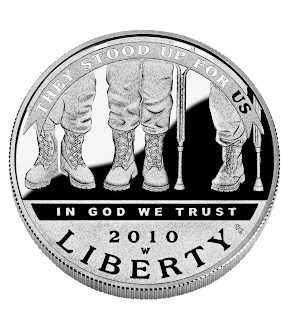Mar 5, 2012 | Baltimore, celebration, commemorative, news, US Mint
Today, March 5, 2012, the 2012 Star-Spangled Banner Commemorative Coins will go on sale with a launch ceremony at the the Fort McHenry National Monument and Historic Shrine. Program is scheduled to begin at 11:00 A.M. at the Visitor Center and sales to begin at 11:30 A.M.
According to the media release from Maryland War of 1812 Bicentennial Commission, the group organizing the bicentennial of what historians consider America’s second revolutionary war against the British, “Those who purchase a coin that day will receive a Certificate of Authenticity from the United States Mint and a special acknowledgement from the Maryland War of 1812 Bicentennial Commission.”
In addition to the coin sales, specially made chocolate versions of the coins will be offered by Kirchmayr Chocolatiers, a Baltimore company specializing in fine European chocolate.
If you cannot make it to Baltimore for the launch, fear not! Your intrepid blogger will be making the trip, camera and iPhone in hand. As part of the trip, I will be live tweeting on Twitter from Baltimore. Follow me @coinsblog to read about the ceremony and see some the pictures I take. I plan to shoot video of the ceremony and will post an edited version later this week.
 Did You Know?
Did You Know?
Fort McHenry was built prior to the War of 1812. The fort is named for
James McHenry, Secretary of War, 1796-1800.
Fort McHenry aerial image and nugget courtesy of the National Park Service.
Nov 11, 2011 | celebration, commemorative, museum
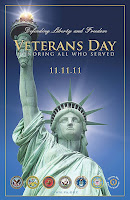 On the “eleventh hour of the eleventh day of the eleventh month” in 1918, hostilities were ended on the Western Front of World War I. Although this is accepted as the end of the “War to End All Wars,” fighting continued across the Russian Empire and in areas of the old Ottoman Empire. A year later, President Woodrow Wilson proclaimed November 11 Armistice Day as a national holiday to celebrate those who served and honor those that died.
On the “eleventh hour of the eleventh day of the eleventh month” in 1918, hostilities were ended on the Western Front of World War I. Although this is accepted as the end of the “War to End All Wars,” fighting continued across the Russian Empire and in areas of the old Ottoman Empire. A year later, President Woodrow Wilson proclaimed November 11 Armistice Day as a national holiday to celebrate those who served and honor those that died.
Alvin King, a shoe repair shop owner in Emporia, Kansas, had the idea to celebrate all veterans on November 11. King lobbied the city of Emporia to close in honor of all veterans. Representative Ed Rees of Emporia shepherded a bill through congress to rename the holiday Veterans Day to honor all who have served. President Dwight Eisenhower signed the bill into law in 1954.
On Veterans Day, we pay tribute to our veterans, to the fallen, and to their families. To honor their contributions to our Nation, let us strive with renewed determination to keep the promises we have made to all who have answered our country’s call. As we fulfill our obligations to them, we keep faith with the patriots who have risked their lives to preserve our Union, and with the ideals of service and sacrifice upon which our Republic was founded.†
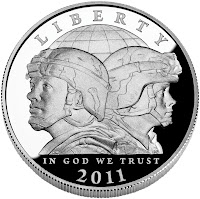 If you are looking for a way to honor veterans, consider supporting The Army Historical Foundation and their effort to build The National Museum of the United States Army. You can support their efforts by donating to the organization or by purchasing a 2011 United States Army Commemorative Coin. Available as a $5 gold coin, $1 silver coin, and half-dollar clad coin, the surcharges ($35 gold, $10 silver, and $5 clad) will be paid to The Army Historical Foundation to support the construction of the museum.
If you are looking for a way to honor veterans, consider supporting The Army Historical Foundation and their effort to build The National Museum of the United States Army. You can support their efforts by donating to the organization or by purchasing a 2011 United States Army Commemorative Coin. Available as a $5 gold coin, $1 silver coin, and half-dollar clad coin, the surcharges ($35 gold, $10 silver, and $5 clad) will be paid to The Army Historical Foundation to support the construction of the museum.
Take this opportunity to honor the nation’s veterans and support this worthy effort.
To all that have served…
To all that have given the ultimate sacrifice…
To the families of these honored service members…
THANK YOU!
† From the Veterans Day, 2011 Presidential Proclamation signed by President Barack Obama.
Veterans Day 2011 poster courtesy of the Department of Veterans Affairs.
Coin image courtesy of the U.S. Mint.
May 24, 2011 | celebration, cents
NumisSociety, an online grass-roots community of numismatists, announced that the community is advocating a “National Spend a 1918 Lincoln Cent Day” on Memorial Day, May 30, 2011.
NumisSociety members were inspired by a story written by Dave Harper in Numismatic News. Harper writes about a letter he received from Army SGT Jarrett Briscoe who is stationed in Kuwait. In the letter, SGT Briscoe sent Harper a 1918 Lincoln Cent he received in change after a transaction with a local. Astonished to find a coin that old and so far away from home, SGT Briscoe asked Harper to “return it home” by putting it back into circulation in the United States.
It was a touching story that inspired the members of the NumisSociety. NumisSociety community members decided to join together to make this a truly memorable Memorial Day. In honor of SGT Briscoe and all members of our Armed Forces present and past, they want as many people to spend a 1918 Lincoln Cent in all 50 United States.
If you are interested, sign up at the NumisSocieity website and let them know (here) what state you will spend a 1918 Lincoln Cent on Memorial Day.
This is such a great idea, that I dug through my excess inventory and found a coin that I will spend on that day (after I remove it from its 2×2). It is the least I can do to be part of this effort to honor those who served and continue to serve on behalf of this country.
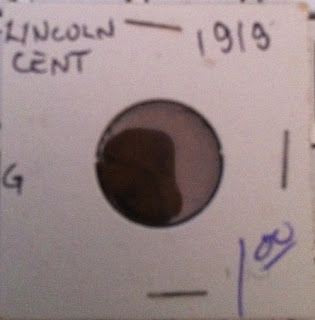
Jul 4, 2010 | celebration, history
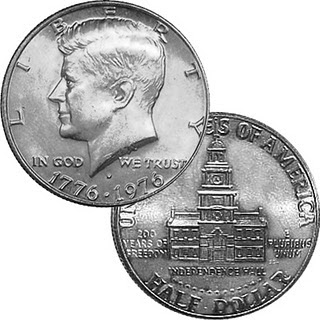 After nearly a year of war and attempted negotiation with King George III and the British parliament, it became clear that the colonies in the New World would continue to be under harsh rule without representation. In January 1776, the Continental Congress met to discuss the matter.
After nearly a year of war and attempted negotiation with King George III and the British parliament, it became clear that the colonies in the New World would continue to be under harsh rule without representation. In January 1776, the Continental Congress met to discuss the matter.
Public support for independence from the British Empire was growing amongst the colonies. Only the “middle colonies” of New York, New Jersey, Delaware, and Maryland who were benefiting financially being part of the British Empire were against independence. When these colonies sent delegations to the Continental Congress, each of their conventions did not allow them to vote for independence.
As the war with Great Britain dragged on and the attempt at tightening their reigns on the colonies persisted, the populous cry for independence grew. Delegates were set back to their governments and representatives sent to the middle colonies to convince them that the colonies had to declare independence for their own survival. As colonies began to line up with the independence movement, Pennsylvania, New York, Maryland, and South Carolina remained reticent on the subject.
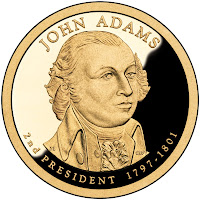 Of the four hold outs, Pennsylvania and Maryland had governments with strong ties to the colonial governors who still had influence. John Adams wrote a draft preamble to explain the independence resolution. Part of the way the resolution was written was, in effect, to overthrow the colonial governments of Pennsylvania and Maryland so that it would be replaced by a popular government. On May 15, 1776, that preamble was passed. The colonies had taken their first step toward independence.
Of the four hold outs, Pennsylvania and Maryland had governments with strong ties to the colonial governors who still had influence. John Adams wrote a draft preamble to explain the independence resolution. Part of the way the resolution was written was, in effect, to overthrow the colonial governments of Pennsylvania and Maryland so that it would be replaced by a popular government. On May 15, 1776, that preamble was passed. The colonies had taken their first step toward independence.
Delegates left the congress and returned to their own colonial conventions. Maryland, whose delegates walked out of the congress in protest, continued to reject the notion of independence. Samuel Chase returned to Maryland and convinced them to allow their delegates to approve the motion of independence. Pennsylvania, New York, and South Carolina remained against the declaration while the Delaware delegates were split.
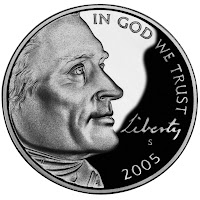 On June 11, 1776, the “Committee of Five” was appointed to draft a declaration. Committee members were John Adams of Massachusetts, Benjamin Franklin of Pennsylvania, Thomas Jefferson of Virginia, Robert R. Livingston of New York, and Roger Sherman of Connecticut. Although no minutes were kept from the committee meetings, it was accepted that the resulting document was largely Jefferson’s work. The Committee of Five completed the draft on June 28, 1776.
On June 11, 1776, the “Committee of Five” was appointed to draft a declaration. Committee members were John Adams of Massachusetts, Benjamin Franklin of Pennsylvania, Thomas Jefferson of Virginia, Robert R. Livingston of New York, and Roger Sherman of Connecticut. Although no minutes were kept from the committee meetings, it was accepted that the resulting document was largely Jefferson’s work. The Committee of Five completed the draft on June 28, 1776.
Debate on the draft began on July 1. After a long day of speeches a vote was taken. Maryland voted yes but Pennsylvania and South Carolina voted no. The New York delegation abstained with out authority from their government to vote. Delaware could not vote because its delegate was split on the question. Edward Rutledge of South Carolina moved to postpone the vote until the next day.
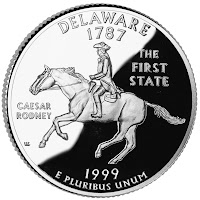 Although there is no written history on what happened that evening, there had to have been lobbying by supporters of independence because on July 2, South Carolina voted yes followed by a turnaround by the Pennsylvania delegation that also voted yes. New York with no authority from their government continued to abstain. With the Delaware delegation deadlocked, this set up the historical ride of Caesar Rodney. Rodney was one of Delaware’s representative to the Continental Congress. He was in Dover attending to other business when he learned that Thomas McKean and George Read were deadlocked on the vote of independence. Rodney rode 80 miles from Dover to Philadelphia to vote with McKean to allow Delaware join eleven other colonies voting in favor of independence.
Although there is no written history on what happened that evening, there had to have been lobbying by supporters of independence because on July 2, South Carolina voted yes followed by a turnaround by the Pennsylvania delegation that also voted yes. New York with no authority from their government continued to abstain. With the Delaware delegation deadlocked, this set up the historical ride of Caesar Rodney. Rodney was one of Delaware’s representative to the Continental Congress. He was in Dover attending to other business when he learned that Thomas McKean and George Read were deadlocked on the vote of independence. Rodney rode 80 miles from Dover to Philadelphia to vote with McKean to allow Delaware join eleven other colonies voting in favor of independence.
With 12 votes for independence and one abstention, the Continental Congress approved the declaration. Jefferson then set forth to make the agreed upon corrections to the document. On July 4, 1776, the Continental Congress approved the wording of the Declaration of Independence. The document was sent to the printer for publication and distribution to the public.
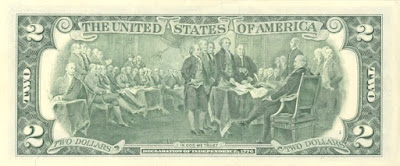
Although historians debate exactly when the final document was signed, it is accepted that the final signatures were added on August 2, 1776. Since New York approved the resolution of independence on July 10, the New York delegation is included amongst the signatures.
As we celebrate the 234th Birthday of the United States of America, please take a moment to remember those who fought for our freedom and continue to do so today. Honoring them is the best way to honor those whose vision created this great nation.
Picture Credits
Kennedy Bicentennial Half and $2 Federal Reserve Note reverse are from Wikipedia
Other coin images are courtesy of the U.S. Mint
Jun 11, 2010 | celebration, coins, commemorative
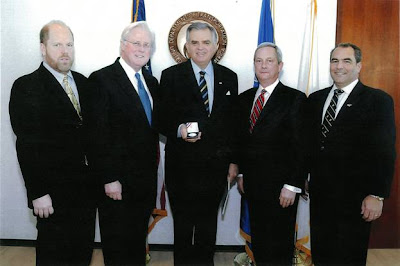
Secretary of Transportation Ray LaHood receives a 2010 American Veterans Disabled for Live Silver Dollar to thank the U.S. Department of Transportation for its support of street and road infrastructure projects surrounding the site of upcoming American Veterans Disabled for Life Memorial in Washington, D.C. The American Veterans Disabled for Life Memorial will be the country’s first national memorial dedicated to living and deceased disabled veterans and is planned for a site within view of the U.S. Capitol. For more information on the Memorial, visit www.avdlm.org. Silver dollars can be ordered from the U.S. Mint with proceeds benefitting the Memorial.
Pictured, left to right (above):
Peter Dickinson, Disabled American Veterans; Ray McGrath, Downey McGrath Group; Secretary Ray LaHood; Barry Owenby, Disabled Veterans LIFE Memorial Foundation; Joseph Violante, Disabled American Veterans.
Aug 6, 2009 | celebration, cents
On Monday, August 2, 1909, people lined up at banks and other distribution points in America’s major cities. It was an event like the country has never seen before. For the first time in the United State’s history, a coin minted for circulation was to carry the portrait of a real person. Sure, the US Mint produced a coin with other portraits, but they were commemoratives and not intended for circulation, even though some did circulate.
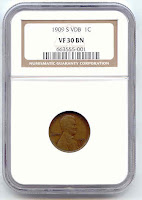 But this was different. This was the portrait of one of our greatest presidents. Abraham Lincoln, our 16th president, was being honored on the cent the year the country celebrated the 100th anniversary of his birth.
But this was different. This was the portrait of one of our greatest presidents. Abraham Lincoln, our 16th president, was being honored on the cent the year the country celebrated the 100th anniversary of his birth.
The new Lincoln Head Cent featured a portrait by Lithuanian immigrant, Victor David Brenner. Brenner, who came to the United States in 1890, learned engraving in New York City and spent the rest of his life honoring his adopted home with beautiful portraits of Lincoln, Theodore Roosevelt, and other leaders.
Even with the excitement the release was not without controversy. Almost instantly, the public did not like the prominence of the artist’s initials “V.D.B.” on the reverse of the coin. On August 5, 1909, Treasury Secretary Franklin MacVeagh ordered production halted in order to remove the initials from the coin’s reverse.
When production was halted, over 27 million were struck in Philadelphia but only 484,000 were struck in San Francisco. With the rumors that the US Mint would recall the VDB cents, speculators saved as many coins as possible. But with only 484,000 minted, the 1909-S VDB became an instant key date in the new Lincoln Cent series.
Chief Engraver Charles Barber removed the initials from the master die but did not add them anywhere else claiming it would too difficult and would take too much time. When George Morgan was named Chief Engraver following Barber’s death immediately and effortlessly added Brenner’s initials to the trunk of the bust.
Brenner’s design lasted 50 years even with a one-year composition change in 1943. In order to preserve copper for the war effort, over 1 billion coins were struck in 1943 on zinc-coated steel planchets—which were not popular when they were circulated.
For the 150th anniversary of Lincoln’s birthday, the US Mint’s Tenth Chief Engraver Frank Gasparro redesigned the reverse of the coin to show the Lincoln Memorial. The obverse would continue to use the Brenner portrait of Lincoln.
As we celebrate the Bicentennial of Lincoln’s birth, the reverse of the coins were redesigned for the celebration. But as it has been since it was introduced in 1909, the cents feature the portrait of Lincoln designed by Victor David Brenner.
Since August 2, 1909, the US Mint says that they have struck over 450 billion Lincoln Cents. This probably makes the Brenner portrait of Lincoln the most duplicated of any portrait in history. Talk about history in your hands!
Jul 4, 2009 | bicentennial, celebration, coins
It was a hot day in Philadelphia when the First Continental Congress met on July 4, 1776 to finalize a resolution that would permanently separate the American colonies from the British Crown. According to the leaders of the day, it was the only way to rid themselves of the unfairness of British rule. In order to ensure that everyone was heard, the Congress adjourned and met as a Committee of the Whole to debate and adopt the resolution.
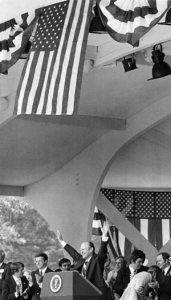
President Gerald Ford Speaking at Freedom Park in Charlotte, NC on May 20, 1975.
Thirty-three years ago, the United States celebrated its Bicentennial with a big celebration. As part of the celebration, the US Mint issued special circulating commemoratives honoring the occasion. For those of us who were born at the end of the Baby Boom generation, this was the first change in coinage we experienced. It was a great experience, especially when I shook hands with President Gerald Ford during a public appearance in Charlotte in 1975.
In honor of the United States Independence Day Celebration, here is my collection of Bicentennial Silver Proof Coins autographed by the artists whose designs were used.
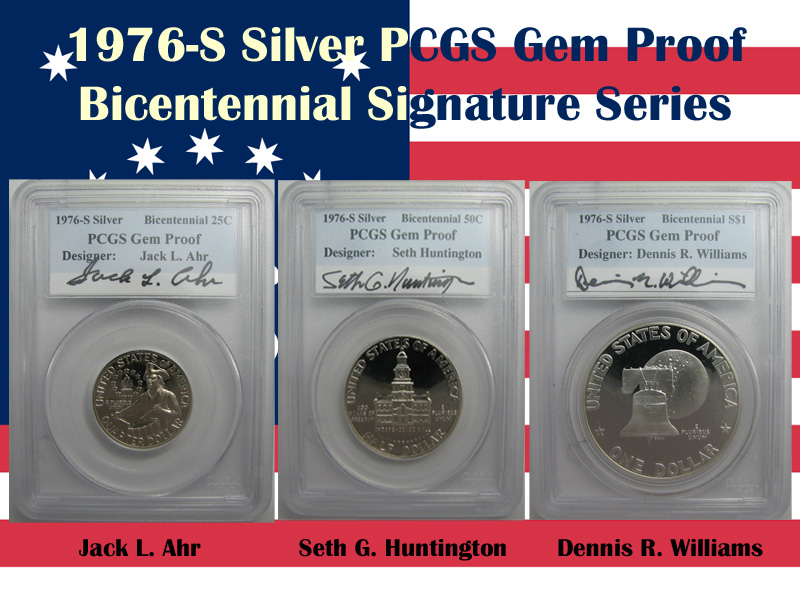
1976-S Silver Proof Bicentennial Autograph Set
Have a Happy and Safe Independence Day and please thank any active duty military service person or veteran today!
Image of President Ford speaking at the Charlotte, N.C., bicentennial celebration on May 20, 1975, courtesy of
Andy Burriss Photography.
 Did You Know?
Did You Know?









